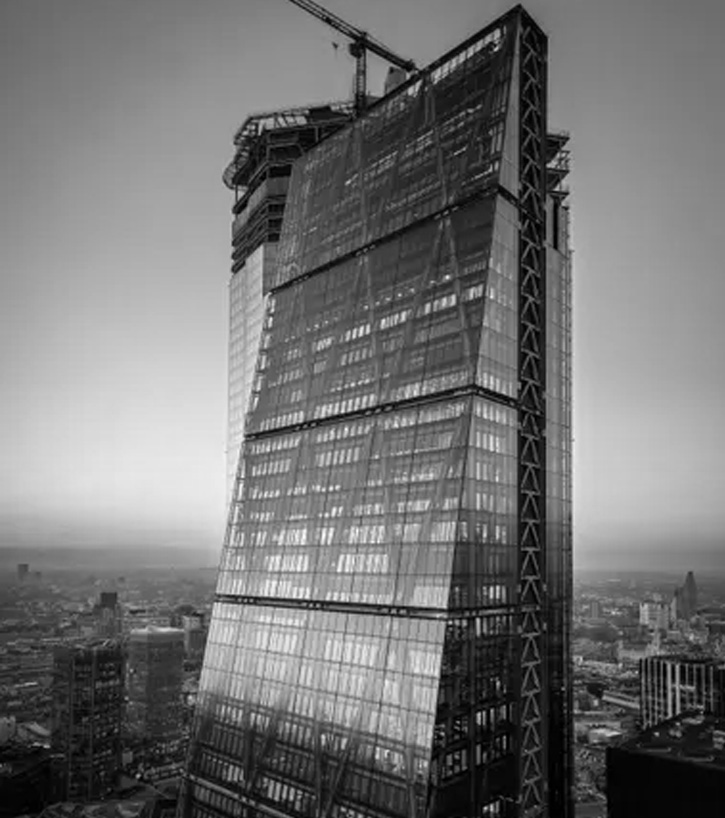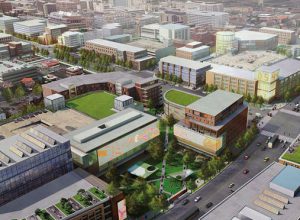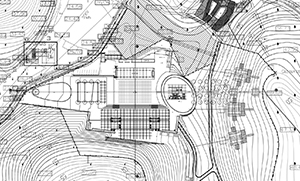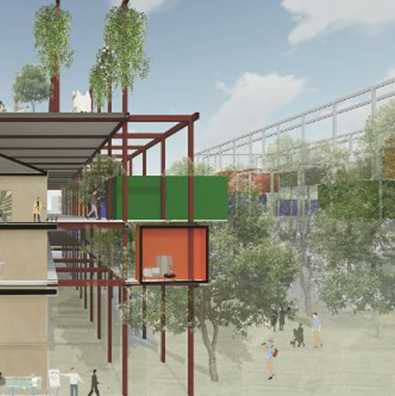Architecture and Design News
By Norman Weinstein
February 2020 12:45 GMT

Leadenhall Building
 intersection along Cincinnati’s Martin Luther King Drive
intersection along Cincinnati’s Martin Luther King Drive
public space. Elizabeth Pandolfi: Community-Responsive Public Spaces Were More Resilient During COVID, Knight Foundation Report Finds: “Adaptive Public Spaces: Places for People in the Pandemic and Beyond” looked at 7 different public spaces…to assess their impact in…design and programming;– Next City (formerly Next American City)
housing. Inga Saffron: Housing advocates see denser buildings as an answer to affordability. But not all density is good density: Two notorious projects help us understand the difference between density that enhances a neighborhood and projects that big-foot their surroundings– Philadelphia Inquirer
Timeline

Kecho Journal | Archive
Architect: Christopher Alexander
Christopher Alexander was an Austrian-born British-American architect and urban theorist. As a builder, he also constructed over 100 buildings in different places worldwide. But he is most known for his influential theories on architecture and urban design, with classic books such as Notes on the Synthesis of Form, The Timeless Way of Building, The Nature of Order Volumes and A Pattern Language. He has died on March 17, 2022 in his home in the south of England after a long illness, according to Archinect.
Typology
The MFAH’s program includes 240,000 sf structure that hosts permanent collection of modern and contemporary art. The building is a synthesis of Holl’s revisited program and the trapezoidal site of the Museum District. Porisity and light continue to be the central theme for Steven Holl in this building, emphasized by the use of translucent glass tubes for cladding. The assembly could reduce cooling requirements by 40 percents, according to Kendall/ Heaton Associates. While the exterior pays tribute to Mies, the interior natural lighting is inspired by Louis Kahn’s Kimbell Art Museum, but “more organic, more dynamic – like the clouds.” Architectural Records
City Architecture
The MFAH’s program includes 240,000 sf structure that hosts permanent collection of modern and contemporary art. The building is a synthesis of Holl’s revisited program and the trapezoidal site of the Museum District. Porisity and light continue to be the central theme for Steven Holl in this building, emphasized by the use of translucent glass tubes for cladding. The assembly could reduce cooling requirements by 40 percents, according to Kendall/ Heaton Associates. While the exterior pays tribute to Mies, the interior natural lighting is inspired by Louis Kahn’s Kimbell Art Museum, but “more organic, more dynamic – like the clouds.” Architectural Records
Sustainability
The MFAH’s program includes 240,000 sf structure that hosts permanent collection of modern and contemporary art. The building is a synthesis of Holl’s revisited program and the trapezoidal site of the Museum District. Porisity and light continue to be the central theme for Steven Holl in this building, emphasized by the use of translucent glass tubes for cladding. The assembly could reduce cooling requirements by 40 percents, according to Kendall/ Heaton Associates. While the exterior pays tribute to Mies, the interior natural lighting is inspired by Louis Kahn’s Kimbell Art Museum, but “more organic, more dynamic – like the clouds.” Architectural Records
—
Design Magazines
AA School
The AA Archive holds a large collection of recordings of lectures,conferences, symposia and other public programme events presented at the AA. Dating back to 1968, the collection includes titles by leading architects, artists, historians, and theorists of the last 50 years including Cedric Price, Reyner Banham, Kenneth Frampton, Peter Cook, Rem Koolhaas and Zaha Hadid.
Arch News Now featuring news from other magazines, including latest debates on the profession, projects and competitions. It also has its own op/ed section.
Architects Journal featuring Building Studies, Specifications, Practice, Podcasts, Film, Magazines, Library and Events.
Architectural Record features Houses, Building Types, Interviews, Book Reviews and Podcasts.
Art News: on architects to “draw the line on designing jails [and such] until America repairs racial injustice,” and “shift their efforts towards ‘supporting the creation of new systems, processes, and typologies'” (it’s not a ban on designing justice facilities).
Designboom: on architects to “draw the line on designing jails [and such] until America repairs racial injustice,” and “shift their efforts towards ‘supporting the creation of new systems, processes, and typologies'” (it’s not a ban on designing justice facilities).
DETAIL: Topics include Sustainability, Researches on Components & Material, Energy & Resources, as well Structure.
Dezeen: on architects to “draw the line on designing jails [and such] until America repairs racial injustice,” and “shift their efforts towards ‘supporting the creation of new systems, processes, and typologies'” (it’s not a ban on designing justice facilities).
Divisare: on architects to “draw the line on designing jails [and such] until America repairs racial injustice,” and “shift their efforts towards ‘supporting the creation of new systems, processes, and typologies'” (it’s not a ban on designing justice facilities).
Domus: on architects to “draw the line on designing jails [and such] until America repairs racial injustice,” and “shift their efforts towards ‘supporting the creation of new systems, processes, and typologies'” (it’s not a ban on designing justice facilities).
Dwell: Photo section dwells on rooms and components: kitchen, bath, bedroom. living, dining, outdoor, kids, office, exterior, storage, doors, windows, staircase, laundry, hallway, garage, shed & studio. The Home Tours section includes Tiny Home, Prefab and Renovations projects.
FORM: on architects to “draw the line on designing jails [and such] until America repairs racial injustice,” and “shift their efforts towards ‘supporting the creation of new systems, processes, and typologies'” (it’s not a ban on designing justice facilities).
Frame: focuses on interior design across typologies: Retail, Hospitality, Work, Institutions, Residences and Shows.
Havard Design Magazine: on architects to “draw the line on designing jails [and such] until America repairs racial injustice,” and “shift their efforts towards ‘supporting the creation of new systems, processes, and typologies'” (it’s not a ban on designing justice facilities).
Inhabitat: on architects to “draw the line on designing jails [and such] until America repairs racial injustice,” and “shift their efforts towards ‘supporting the creation of new systems, processes, and typologies'” (it’s not a ban on designing justice facilities).
Juxtapoz: on architects to “draw the line on designing jails [and such] until America repairs racial injustice,” and “shift their efforts towards ‘supporting the creation of new systems, processes, and typologies'” (it’s not a ban on designing justice facilities).
l’Architecture d’Aujourd’hui: on architects to “draw the line on designing jails [and such] until America repairs racial injustice,” and “shift their efforts towards ‘supporting the creation of new systems, processes, and typologies'” (it’s not a ban on designing justice facilities).
Metropolis: on architects to “draw the line on designing jails [and such] until America repairs racial injustice,” and “shift their efforts towards ‘supporting the creation of new systems, processes, and typologies'” (it’s not a ban on designing justice facilities).
Places Journal: on architects to “draw the line on designing jails [and such] until America repairs racial injustice,” and “shift their efforts towards ‘supporting the creation of new systems, processes, and typologies'” (it’s not a ban on designing justice facilities).
Tạp chí Kiến Trúc: on architects to “draw the line on designing jails [and such] until America repairs racial injustice,” and “shift their efforts towards ‘supporting the creation of new systems, processes, and typologies'” (it’s not a ban on designing justice facilities).
The Architects Newspaper: on architects to “draw the line on designing jails [and such] until America repairs racial injustice,” and “shift their efforts towards ‘supporting the creation of new systems, processes, and typologies'” (it’s not a ban on designing justice facilities).
The Art Newspaper: on architects to “draw the line on designing jails [and such] until America repairs racial injustice,” and “shift their efforts towards ‘supporting the creation of new systems, processes, and typologies'” (it’s not a ban on designing justice facilities).
The Guardian: on architects to “draw the line on designing jails [and such] until America repairs racial injustice,” and “shift their efforts towards ‘supporting the creation of new systems, processes, and typologies'” (it’s not a ban on designing justice facilities).
Uncube: on architects to “draw the line on designing jails [and such] until America repairs racial injustice,” and “shift their efforts towards ‘supporting the creation of new systems, processes, and typologies'” (it’s not a ban on designing justice facilities).
Zinio: on architects to “draw the line on designing jails [and such] until America repairs racial injustice,” and “shift their efforts towards ‘supporting the creation of new systems, processes, and typologies'” (it’s not a ban on designing justice facilities).




